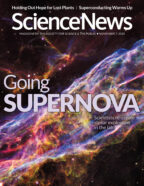This post was originally published on this site

Waiting to exhale
Cuvier’s beaked whales may rely on large stores of oxygen, a slow metabolism and the ability to tolerate lactic acid to dive for hours without surfacing for air, Erin Garcia de Jesus reported in “A beaked whale’s nearly four-hour-long dive sets a new record” (SN: 11/7/20, p. 5).
“Your report on Cuvier’s beaked whales’ long dives begins: ‘To break the record for longest dive by a marine mammal, take a deep breath and jump in the water,’ ” reader John Hoskins wrote. “Do these whales inhale or exhale before diving?” he asked. Hoskins noted that northern elephant seals exhale before diving deep. That, along with flexible rib cages, helps those mammals’ lungs collapse as water pressure increases.
Cuvier’s beaked whales exhale most of the air from their lungs before diving, Garcia de Jesus says, and the whales also have flexible rib cages. “It seems that Cuvier’s beaked whales have very similar diving methods to northern elephant seals,” she says.
Swept away
Bacteria and other microbes that get swept into the atmosphere can end up in clouds and influence weather, Cassie Martin reported (SN: 11/7/20, p. 4) in an update to a 1970 article “Clouds may be ecosystems” (SN: 11/14/70, p. 384).
Reader Mike Sevilla wondered if clouds could spread the algae responsible for harmful red tides. “Can the clouds pick up and carry [the algae]?” he asked. “Great food for thought over toast and tea.”
It’s possible that some algae could get swept into the atmosphere where they might seed clouds, Martin says. “But those species haven’t been documented in samples of cloud water to my knowledge.” It’s also unclear if the organisms would survive the trip. “Microbial meteorology is a relatively new field,” Martin says. “While researchers don’t yet have an answer for whether clouds disperse algae that go on to form red tides, the question is definitely worth discussing during your next teatime chat.”
It’s a small world after all
A photo of a zebrafish’s lymphatic system took top honors in the 2020 Nikon Small World photography contest, Erin Garcia de Jesus reported in “A glowing zebrafish wins the 2020 Nikon Small World photography contest” (SN: 11/7/20, p. 32).
The third-place winner, featured in an online version of the story, was a magnified image of a snail tongue. Reader Orlando Saint-Sebastien was surprised to learn that snails have tongues and asked how sticky they are.
Snail tongues come in various shapes, sizes and textures. Igor Siwanowicz, a photographer and neurobiologist at Howard Hughes Medical Institute’s Janelia Research Campus in Ashburn, Va., doesn’t think the tongue of the freshwater snail he photographed was sticky. Siwanowicz admits that he’s never been licked by a snail, but he imagines the tongue would feel like fine sandpaper. “More like a cat’s than a chameleon’s tongue,” he says.
Serendipity with a dash of salt
Passion and happy chance encounters connect botanists studying rare plants and a physicist trying to replicate supernova explosions in the lab, Nancy Shute wrote in “In praise of serendipity — and scientific obsession” (SN: 11/7/20, p. 2).
“That’s only the half of it,” reader Thomas Nied wrote. In “Giant lasers help re-create supernovas’ explosive, mysterious physics” (SN: 11/7/20, p. 20), Emily Conover “writes that as a graduate student in the 1980s, the physicist Hye-Sook Park worked on ‘an experiment 600 meters underground in a working salt mine beneath Lake Erie.’ Although the story doesn’t say, that salt mine under Lake Erie was owned and operated by Morton Salt, with its headquarters in Chicago,” Nied wrote.
Meanwhile, part of “How passion, luck and sweat saved some of North America’s rarest plants” (SN: 11/7/20, p. 14) is set in Morton Arboretum in Lisle, Ill. “The same Morton who funded the arboretum founded the salt mine…. But, at this point, to paraphrase [journalist and author] Walter Lippmann, ‘the facts have far exceeded my curiosity,’ ” Nied wrote.
Rhythm of the night
Music created from telescope data helps people with visual impairments experience the wonders of astronomy, such as the Pillars of Creation, and could aid research, Maria Temming reported in “Turning space images into music makes astronomy more accessible” (SN: 11/7/20, p. 4). On Facebook, reader Alexander Micheal Carter praised the effort with a pun: “Love it!!! Great algor-rhythms.”
